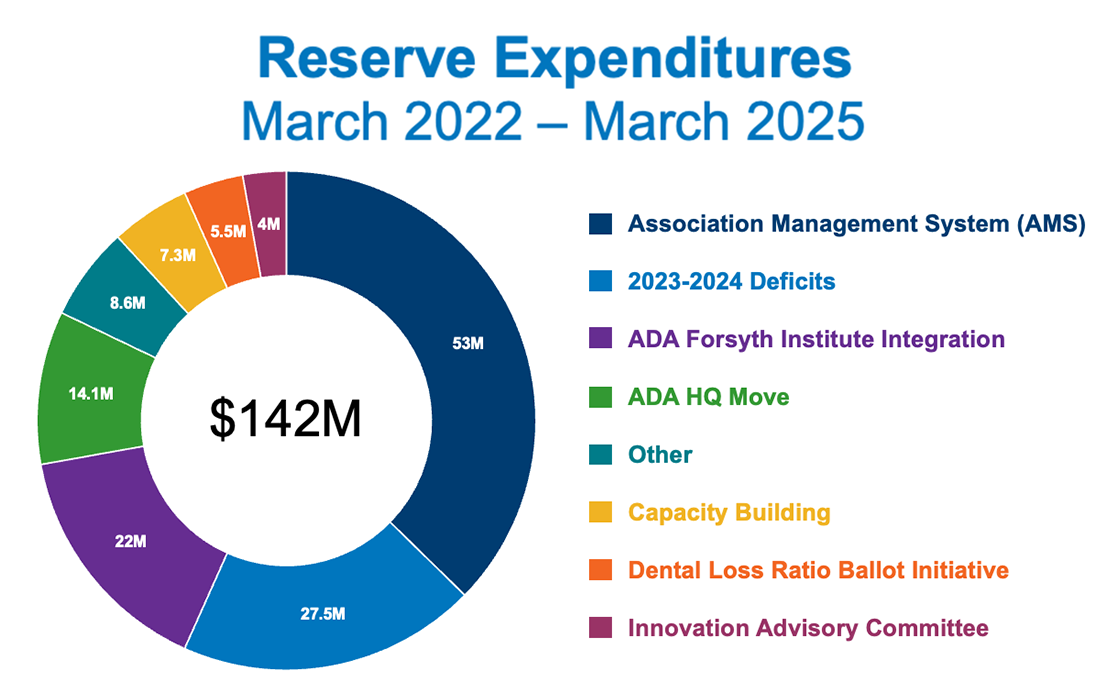ADA Board provides information on finances, association management system
Pens open letter to membership

Editor's note: The ADA Board of Trustees emailed all members on July 10 with an update on the state of the Association's finances and technology upgrades. ADA News repurposed their message into an open letter.
Over the past few months, your Board of Trustees has engaged in difficult yet necessary conversations about the challenges confronting our organization and the ripple effects of change throughout the Tripartite.
Through webinars and in-person presentations, ADA President Brett Kessler, D.D.S., and President-elect Rich Rosato, D.M.D., have also shared how these changes impact the state of the ADA — answering questions from leaders across the country, as well as addressing all members in May via email and ADA News.
The Board acknowledges its responsibility — despite acting purposefully with the best available information at the time — and recognizes that we owe all ADA members a deeper explanation of the “why” behind these changes, the associated spending, and what we are doing going forward to help build a strong future for you, our Association, profession, and patients.
Here are the facts:
• $142 million was spent from ADA reserves funds from March 2022 to March 2025. These expenditures were deemed necessary by the ADA executive director and the Board of Trustees to support critical upgrades to organizational systems, strengthen advocacy efforts and address other key priorities.
• Of the $142 million in expenditures, $53 million was allocated to the new association management system, which supports essential membership functions at the local, state and national levels of the ADA. Currently, 47 states are enrolled as users of the system. Based on this participation, had each participating dental society paid a share of the cost, it would have averaged approximately $1.3 million per state. The ADA purchased and implemented the previous association management system — Aptify — for ADA national in 2011, with funding provided via a member assessment for Information technology. Roll out to the states, which was not without challenges, began in 2012 with additional funding approved from reserves in 2013 and 2015 for accelerated deployment and remediation, respectively.
• ADA collective reserve funds amounted to $167 million as of April 30 (this figure includes our Headquarters Building Quasi-Endowment Fund).
• Our membership market share as of year-end 2024 is 53.5% down 3.3% from 2023.
With the best of intentions and based on the information available, the ADA Board of Trustees approved investments aligned with a business plan aimed at growth and innovation for the ADA. In hindsight, we understand that rapid, large-scale change can lead to unintended consequences, including financial strain and questions on leadership’s decision making.
As we move forward, we are committed to placing transparency at the heart of our decision-making and to prioritizing collaboration at every step. We value your trust, and we are dedicated to rebuilding and strengthening it together.
How we got here
In 2021, the Board considered some tough realities: Membership market share figures dating back to 2007 continued to trend downward. Projections indicated ADA’s market share would be less than 50% in 2026 unless this trend was reversed. At the same time, nondues revenue was down.
For ADA to remain at the forefront of the profession — to be the nation’s credible, united voice on oral health for all — action was necessary.
We were presented with a business plan full of forward-thinking ideas to grow membership and nondues revenue. With a strong reserve fund of $205 million in March 2022, the Board believed it was imperative to accelerate investing in the ADA’s future to attempt to reverse downward trends and advance organizational growth for you and future generations of the profession.
Investments funded from ADA reserves over the past few years include those shown in the graphic at the top of this article.
Where things stand today
As previously noted, ADA collective reserve funds amounted to $167 million as of April 30 (this figure includes our Headquarters Building Quasi-Endowment Fund). Following a financial review, the Board determined that the expected revenue growth and cost-saving measures for fiscal years 2024-25 have not occurred. Compared to year-to-date April 2024, year-to-date April 2025 revenue is down by 6% excluding the favorable impact of the sale of an ADA building in Washington, D.C.
As your Board, and in keeping with our fiduciary responsibilities, we are committed to focusing on and funding programs that prioritize member success while being mindful of the ADA Strategic Forecast goals.
Here are updates on two of our biggest priorities: the association management system and finances overall.
Association management system: The ADA’s previous system, Aptify, was outdated and heavily customized to meet the specific needs of individual dental societies, making it increasingly vulnerable to data breach and unsustainable. While the new association management system was originally planned as a four-year project, its implementation was significantly accelerated.
Since this was no “flick of the switch” conversion to begin with, time-consuming and costly difficulties resulted from this acceleration which became apparent during the 2024 join and renew season. Remediation to achieve a stable association management system is underway, with dedicated staff collaboration with an outside firm specializing in system stabilization in anticipation of the next membership renewal cycle.
Status: The organization is moving forward with a target of 90% association management system stability by September to ensure a smooth membership renewal season. As of mid-June, we are on track at 60%. An ADA team dedicated to remediation efforts holds regular progress meetings with dental societies, responding as promptly as possible to resolve concerns. A project management firm is also supporting stabilization via improved processes and rigor. Association management system stabilization is the ADA’s highest priority because it is so essential for dental societies’ membership efforts and enables communication with you, our members.
Finances: As shared with you in the May message from our president and president elect, a financial review in Q1 2025 found larger-than-expected variances between the ADA’s planned first-quarter budget and actual income and spending. One example is the unexpected overage in costs related to the implementation of the new association management system.
To address this, the Board rescinded the previous budget and directed a revamped 2025 budget be created for review by the Board with a targeted expense reduction of $20 million.
Status: The Board remains focused on reducing deficit spending for the remainder of 2025 while strategically planning for 2026. In close collaboration with ADA councils, committees, and the House of Delegates, we are committed to making thoughtful, data-driven decisions that prioritize sustainable progress for the organization.
As your Board of Trustees, we stand united in this message. As the ADA's management body, we made decisions to support the Association based upon the facts and information we had available to us at the time. We accept responsibility and ask for your understanding as we move forward with a focus on priorities, timelines and finances as we work to deliver greater value to you.
The ADA belongs to you, and we pledge to work hard on your behalf. Our mission exemplifies where we’re headed, not just as an organization but as a profession. Together, we will listen and learn, creatively address our challenges, defend clinical autonomy, and stay rooted in our purpose and vision for what is possible.
Please share your thoughts with us at msc@ada.org, and we will continue to share more information as it becomes available.
GRAPHIC FOOTNOTE:
Association Management System: Ongoing effort for centralized system for local, state and ADA national to house member information, process memberships and customize recruitment and retention outreach. ADA covered cost for all participating state and locals.
2023-24 deficits: Used to cover two years of deficit spending.
ADA Forsyth Institute integration: Acquisition of world-renowned oral health research institute with revenue potential; consolidation with ADA research facilities to one location.
ADA headquarters move: Cost of move and build-out of rented floors at 401 N. Michigan, after selling 211 E. Chicago at above market rate and securing favorable lease terms in new building.
Other: Examples include ADA accreditation system updates, supplemental spending in the State Public Affairs program and severance costs.
Capacity building: Modernizing data governance processes required system and data analytics resources, now built into the 2025 budget.
Dental loss ratio ballot initiative: Contribution helped dental loss ratio ballot pass in Massachusetts and set stage for advocacy elsewhere. Thirteen states have adopted dental loss ratio laws requiring insurance companies adhere to dental loss ratio standards ranging from full transparency to setting limits on administrative expenses for marketing and executives’ salaries.
Innovation Advisory Committee: Established to advise Board on strategic investments and new products. Investments were made in three companies for long-term, non-dues revenue. Investments currently paused.



